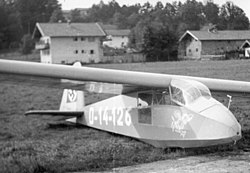Akaflieg Munich Mü 10
| Akaflieg Munich Mü 10 "Milan" | |
|---|---|

|
|
| Type: | Glider |
| Design country: | |
| Manufacturer: | |
| First flight: |
1934 |
| Number of pieces: |
1 |
The Akaflieg München Mü 10 "Milan" is a glider belonging to the student flying group Akaflieg München and is considered the first completely in-house design by Egon Scheibe . With the covered tubular steel fuselage, he founded the so-called Munich School , which had a strong influence on glider construction. It is considered one of the most successful constructions of the student group.
history
In the early 1930s, Akaflieg Munich wanted to build a two-seater performance glider. The aircraft was designed by Egon Scheibe, who later also designed the successful Akaflieg Mü 13 and founded the Scheibe-Flugzeugbau GmbH . The construction work was completed in 1932 and in 1934 Egon Scheibe himself made the successful first flight. Subsequently, numerous successes could be achieved with the aircraft, such as distance records and Alpine crossings as well as the superior overall victory in the 18th Rhön glider flying competition in 1937. Towards the end of the war, the aircraft was handed over to the Deutsches Museum , where it survived the Second World War almost without damage.
After the Allies approved the sport of gliding in the early 1950s, the students at Akaflieg Munich needed a two-seater training aircraft , so the Mü 10 “Milan” was brought back from the Deutsches Museum and repaired. It was re-registered with the registration D-1001 as the first aircraft in Bavaria before it was finally handed over to the Deutsches Museum in 1962 after more than 25 years of operation and 1,800 flight hours. Today it can be viewed in the Flugwerft Schleissheim , a branch of the Deutsches Museum.
construction
The hull of the self-supporting shoulder- wing decker consists of a welded tubular steel frame covered with fabric, while the trapezoidal surfaces are made of wood. The profile was based on a self-developed Mü profile, which was designed for a lot of lift at low speeds. The passenger sits in the high-wing aircraft directly under the wing and can get on and off via a pivoting door on the left. This door was partly used as an additional brake flap during landing . Another special feature is the asymmetrically divided wing.
variants
With the Mü 24 "Milan II" there were plans for an improved version of the Mü 10 after the war. The aircraft should be aerodynamically improved and the asymmetrical wing division abandoned. But the project was never realized.
Technical specifications
| Parameter | Data |
|---|---|
| crew | 2 |
| span | 17.80 m |
| length | 6.75 m (9.20 m with folded surfaces) |
| height | 1.50 m |
| Wing area | 20.00 m² |
| Wing loading | 18.25 kg / m² |
| slightest sinking | 0.65 m / s at 50 km / h |
| Preparation mass | 185 kg |
| Payload | 180 kg |
| Max. Takeoff mass | 365 kg |
| Wing extension | 15.85 |
| Top speed | 180 km / h |
| Glide ratio | 22 at 70 km / h |
See also
literature
- Georg Brütting: The most famous gliders . Motorbuch, Stuttgart 1997, ISBN 978-3-87943-171-7 .
- Frank-Dieter Lemke, Rolf Jacob: Research - Build - Fly. The Academic Fliegergruppen (Akaflieg) in Germany until 1945. Part 1. In: Flieger Revue extra, 29th issue, June 2010, pp. 18–31.
- Martin Simons: Sailplanes 1920–1945 . EQIP, Königswinter 2001, ISBN 3-9806773-4-6 .
Web links
Individual evidence
- ↑ The Mü 10 "Milan" on the Akaflieg Munich website ( memento from March 4, 2016 in the Internet Archive ), accessed on July 21, 2012
- ↑ Frank-Dieter Lemke, Rolf Jacob: Research - Build - Fly. The Academic Fliegergruppen (Akaflieg) in Germany until 1945. Part 1. In: Flieger Revue extra, 29th issue, June 2010, p. 22.
- ↑ The Mü 24 “Milan II” on the Akaflieg Munich website , accessed on July 21, 2012
- ^ Helmut Schneider: Airplane Type Book. Handbook of the German aviation and accessories industry. Reprint of the original edition from 1944. Gondrom, Bindlach 1986, ISBN 3-8112-0484-X , p. 292.
